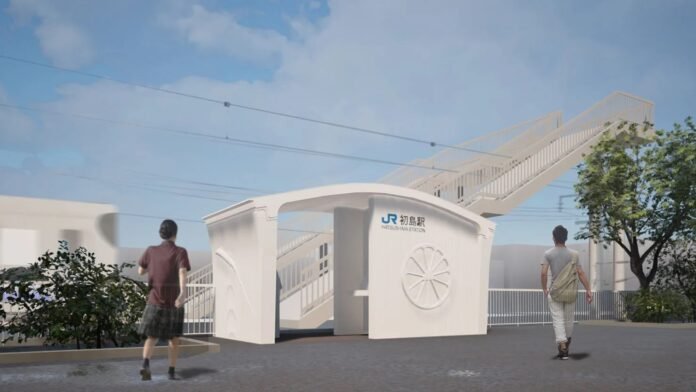
In the quiet town of Arida, where trains have rumbled past for decades, a futuristic revolution unfolded almost overnight. Beneath the cover of darkness and the watchful eyes of engineers, Japan ushered in a new era — one where concrete is printed, time is compressed, and infrastructure gets a digital reboot.
This isn’t the premise of a sci-fi novel. This is Hatsushima Station — the world’s first 3D-printed railway station, unveiled by Japan’s West Japan Railway Company (JR West). Rising from the ashes of a weathered wooden predecessor that had served since 1948, the new station isn’t just a structure; it’s a symbol — of innovation, adaptation, and a future-ready mindset.
A Station Built in Six Hours? Believe It.
The word “construction” usually brings to mind long months of scaffolding, dust, delays, and drilling. But Hatsushima’s makeover rewrites the playbook.
How fast was it built? Try under six hours.
Thanks to the creative minds at Serendix, a trailblazing construction firm, the components for the station were 3D-printed over just seven days in Kumamoto Prefecture. The materials? A specialized, super-durable mortar — think of it as the concrete of tomorrow, engineered for endurance. Once printed, the components made a 500-mile journey across Japan to Arida.
Then, under the stars and after the last train departed, the assembly began. With cranes lifting each prefabricated piece into place like Lego blocks of the future, the entire station was standing — ready and real — before sunrise.
Though compact at just over 100 square feet (about the size of a studio apartment), the station is sturdy, sleek, and efficient. Final touches — like interior finishes and ticketing systems — are still underway, but the structure itself is ready to serve.
Why This Innovation Matters
This isn’t just a cool tech story. This is a vital solution to a national challenge.
Japan is ageing — rapidly. With fewer workers available and rural infrastructure deteriorating, traditional construction just can’t keep up. Rebuilding or repairing even a modest railway station can take two to three months and a sizable workforce. Hatsushima proves that with 3D printing, what once took months now takes mere days — even hours on site.
The implications are profound. Remote or declining regions could now receive updated infrastructure quickly and affordably. Maintenance bottlenecks? Reduced. Labour shortages? Sidestepped. Construction waste? Minimized.
Japan Is Just the Beginning
The world is watching — and following suit.
India, for instance, has entered the game with sustainable flair. In Pune, Godrej Properties recently revealed the country’s first 3D-printed villa, designed using recycled materials to shrink the carbon footprint. The house is more than just shelter — it’s a prototype of greener, faster housing for a growing population.
In the United States and parts of Europe, 3D-printed homes are being tested in disaster relief zones, eco-communities, and urban micro-living solutions. The momentum is real, and it’s accelerating.
What’s Next for Hatsushima — and Beyond
Set to officially open its digital doors in July 2025, Hatsushima Station is just the first chapter. JR West sees this as a test case — a live, functioning proof-of-concept. If all goes well, we could see more such stations blooming like mushrooms across Japan’s rail network, especially in lesser-populated areas.
It’s not hard to imagine a future where portable 3D-printers roll in like caravans, building emergency shelters, bus stops, medical centres — wherever and whenever they’re needed.
Final Stop: A Glimpse into Tomorrow
In a world juggling environmental urgency, labour shortages, and infrastructure decay, 3D printing offers a poetic solution: build less, but build smarter. Let machines do the heavy lifting, while humans dream bigger.
Hatsushima Station might be small in size, but it marks a giant leap in how we think about space, time, and construction. It’s not just a train station — it’s a portal into the possibilities of modern architecture and tech-powered resilience.
So next time you’re waiting for a train, look around. The platform you’re standing on might be the next thing to be printed, not poured.
All aboard the future. It’s arriving faster than you think.

